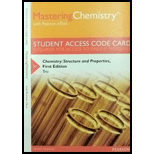
Concept explainers
Interpretation:
We know that intrusive igneous rock has cooled slowly from magma. Rhyolite has cooled very quickly. The intrusive rock has cooled slowly, at depth, where the overlying rocks have an insulating effect, but the extrusive rock has cooled quickly on the surface you know that granite is more crystalline than Rhyolite, it becomes clear that rate of cooling has a direct effect on the physical appearance of the rock.
Concept introduction:
Rate of cooling effect the amount of crystallisation. Slow cooling gives larger size of crystal but fast cooling gives smaller size of crystal. And very fast cooling gives amorphous solid.
To determine: the difference between that is cooled slowly and that is cooled quickly
Want to see the full answer?
Check out a sample textbook solution
Chapter 13 Solutions
MasteringChemistry with Pearson eText -- Standalone Access Card -- for Chemistry: Structure and Properties
- Describe the features of Network Covalent Atomic Solids, Carbon and Silicates?arrow_forwardDescribe the difference between vitreous silica and soda-lime glass. What are some advantages and disadvantages of each of these types of glass?arrow_forwardWhat are some advantages and disadvantages of vitreous silica and soda-lime glass?arrow_forward
- Boron nitride (BN) exists in two forms. The first is a slippery solid formed from the reaction of BCl3 with NH3, followed by heating in an ammonia atmosphere at 750C. Subjecting the first form of BN to a pressure of 85,000 atm at 1800C produces a second form that is the second hardest substance known. Both forms of BN remain solids to 3000C. Suggest structures for the two forms of BN.arrow_forwardCalculate the mass fractions of phases present in an alloy of lead tin with 35% Sn and 65%Pb and at 184° C?arrow_forwardWhat are Non=Oxide-Ceramic? Give some examples?arrow_forward
 Chemistry: The Molecular ScienceChemistryISBN:9781285199047Author:John W. Moore, Conrad L. StanitskiPublisher:Cengage Learning
Chemistry: The Molecular ScienceChemistryISBN:9781285199047Author:John W. Moore, Conrad L. StanitskiPublisher:Cengage Learning Chemistry: Principles and PracticeChemistryISBN:9780534420123Author:Daniel L. Reger, Scott R. Goode, David W. Ball, Edward MercerPublisher:Cengage Learning
Chemistry: Principles and PracticeChemistryISBN:9780534420123Author:Daniel L. Reger, Scott R. Goode, David W. Ball, Edward MercerPublisher:Cengage Learning General Chemistry - Standalone book (MindTap Cour...ChemistryISBN:9781305580343Author:Steven D. Gammon, Ebbing, Darrell Ebbing, Steven D., Darrell; Gammon, Darrell Ebbing; Steven D. Gammon, Darrell D.; Gammon, Ebbing; Steven D. Gammon; DarrellPublisher:Cengage Learning
General Chemistry - Standalone book (MindTap Cour...ChemistryISBN:9781305580343Author:Steven D. Gammon, Ebbing, Darrell Ebbing, Steven D., Darrell; Gammon, Darrell Ebbing; Steven D. Gammon, Darrell D.; Gammon, Ebbing; Steven D. Gammon; DarrellPublisher:Cengage Learning ChemistryChemistryISBN:9781305957404Author:Steven S. Zumdahl, Susan A. Zumdahl, Donald J. DeCostePublisher:Cengage Learning
ChemistryChemistryISBN:9781305957404Author:Steven S. Zumdahl, Susan A. Zumdahl, Donald J. DeCostePublisher:Cengage Learning Chemistry: An Atoms First ApproachChemistryISBN:9781305079243Author:Steven S. Zumdahl, Susan A. ZumdahlPublisher:Cengage Learning
Chemistry: An Atoms First ApproachChemistryISBN:9781305079243Author:Steven S. Zumdahl, Susan A. ZumdahlPublisher:Cengage Learning





